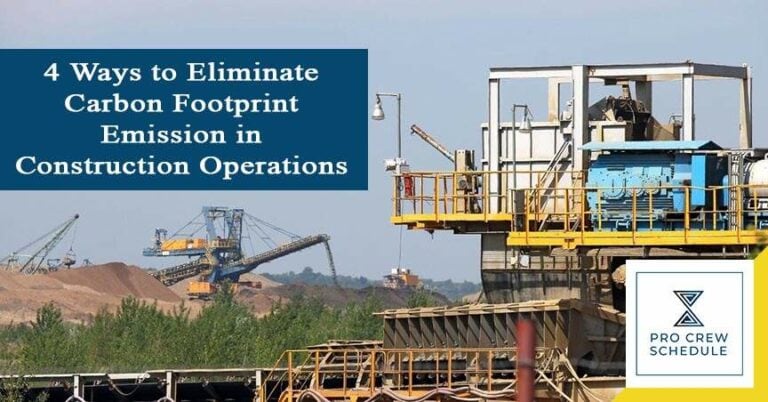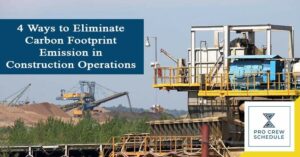Management and reducing carbon footprint as part of a low carbon strategy, with its fundamental cost efficiency and revenue opportunities, is critical in construction design and operations. Building green and sustainable structures are one of the best strategies to mitigate climate change since the technology to reduce significant energy and carbon dioxide emissions exists.
Can you say that your construction company is eco-friendly? Have you ever considered shifting your business to more sustainable processes? Reducing the carbon footprint in construction doesn’t have to mean radical changes or huge investments.
In this blog, we will have a reality check on the carbon emission in construction, the four R’s of green operations on-site, ways to lessen the emission of toxic footprints and implement technology in every trade to enforce a more sustainable build.
Let’s dive right in.
The Reality of Carbon Emission Brought by Construction Industry
Before we discuss reducing carbon footprint, let’s begin with defining it first. A carbon footprint is the amount of greenhouse gases (including methane and carbon dioxide) generated from our actions. Generally, the average carbon footprint a person emits per year is 16 tons in the United States, according to The Nature Conservatory Research. Globally, it was discovered that the average is closer to 4 tons.
Lowering carbon footprint is not possible overnight, especially in an industry as big as construction. We can start by implementing small changes in our actions daily to make a significant change in the long run.
What is Operational Carbon Emission in Construction?
Operational carbon is the emissions from building operations, such as keeping the building cool or turning the lights on. Operational carbon covers 28% of our total carbon emissions. On the other hand, the construction life cycle itself causes 11% of carbon emissions, according to the Institute of Business and Economic Research.
The good news is, the construction industry is starting to take some steps towards lower operational impacts, and the benefits of green construction are beginning to be acknowledged by building owners. To say the least, this reduction of carbon footprint needs to continue. Some of the benefits associated with green buildings include the following:
- Less operating costs
- Higher asset value
- Safer and healthier environments for occupants
Now it brings us to the question: what actual actions can your construction company do to help this pressing global issue? When we hear “reduction of carbon footprint,” we often think of dramatic changes that would involve restructuring the company or investing in expensive or high-level technology. Indeed, your company can probably do it if you have a lot of money lying around and extra time for testing and implementation. However, we believe that atomic changes are more beneficial than waiting for everything to be perfect before doing anything, for that matter.
Here are a few but proven tips you can implement in your construction project for a greener build.
Ways to Reduce Carbon Footprint in Construction
1. Incorporate the Four R’s of Sustainable Construction
a. Reduce
Take a look at your company’s assets. Is the operation of your equipment and machine optimized? Sometimes, you forget that some of the devices are unnecessarily turned on. This can cost a lot of energy and even money when it is preventable and can be saved to be used for more critical activities.
b. Reuse
After the project close-out and hand-over to the project owner, you find yourself left with a mountain of unused materials. Before you categorize them as garbage, consider them as sources for future construction projects. If you are already implementing this practice, try to level up by using more sustainable materials for more eco-friendly buildings.
c. Refuse
Fast, cheap, and band-aid solutions in construction are incredibly tempting. After all, why pay bigger for something you can get at a low price? Well, not until it needs to be replaced. Review the solutions you implement in your construction projects— are they designed to last for years, sustainable, not toxic to the environment, and bring more quality outputs? Reflect, evaluate, and change accordingly.
d. Recycle
Sometimes, it is almost impossible to manage a construction project zero-waste, primarily when most supplies are delivered in plastics. However, we can think of ways to recycle these wastes instead of throwing them straight into the garbage after serving their purpose.
2. Water Efficiency
In this critical day and age, we should stop looking at water as a never-ending resource—as this is not the case anymore. There are various water-saving initiatives and practices you can consider to address the water conversation concern. Surface runoff from project sites can contain toxic pollutants such as fuel and oil from machinery, solvents, paints, and other harmful chemicals and debris that can sink into the earth. These contaminants have a potential the natural water supply of animals and humans and could cause deadly effects in the environment. Now, what action can we take to avoid it?
a. Proper Scheduling
Adequate scheduling allows you to plan all the stages of your construction project efficiently, which can help limit the risk of surface runoff anytime.
b. Consider Your Surrounding Environment
If your site is located near a watercourse, be sure to include a considerable space between them so contaminated elements won’t penetrate the water supply source.
c. Regularly Check Quality
Leaking fixtures and pipes are among the most common offenders in water waste. Checking these water-bearing components regularly to identify potential leaks can be beneficial in the long run.
4. Use Sustainable Building Materials
As the construction industry progresses, different options began to rise as well— especially in building materials. One of the most sustainable building materials is timber. Using timber as a substitute to the traditional materials in construction can reduce material emissions and localized sustainably managed forests.
We can also ask ourselves this: do you know where your building material comes from and how they are done? Are the processing and manufacturing stages they go through ethical? This is a crucial matter to take into consideration, as mass production and bulk transportation can also make a significant impact on the carbon blueprint.
5. Implement New Technology in Every Trade
Advance your construction company by incorporating innovative tools and technology. You don’t have to change all your processes, machines, and tools all at once— but it is worth considering when thinking about your day-to-day operations on-site. Below, we will present tips that you can implement as innovative improvements in respective trades in your construction projects:
a. HVAC
Since HVAC covers 40 percent of the total carbon emissions in a building, including the most efficient ventilation, heating, air-conditioning, and scheduled maintenance can help in the reduction of carbon footprint.
Equipping a building with smart sensors that can measure indoor air quality and how much ventilation is needed would be a great addition as well. This translates to less natural gas, and electricity will be required for the HVAC system, which reduces energy bills and lowers the building’s carbon footprint.
b. Continuous Insulation
Continuous insulation is typically installed on the interior, exterior, or any opaque surface of the building. Continuous insulation saves energy and provides thermal, water, air, and vapor control layers in one building system to simplifies the construction process.
c. Lighting
Lighting uses approximately 40 percent of the energy used in a conventional commercial building. Solar thermal lowers carbon footprints, but too much of this in summer can cause overheating and heightens the need for cooling. However, too little solar gain in winter also increases the need for heating. Using solar control window films can help reduce carbon footprints by cutting energy usage by up to 30 percent.
d. Recycled Content
Check the recycled content of your building and interior materials. Opt for recyclable building materials that have less effect on the environment. Support sustainable vendors and suppliers that embrace green practices and sell eco-friendly materials.
e. Location
A building’s location has a direct impact on the overall carbon footprint it emits. Where a structure is built can impact the potential for carbon buildup in the landscape and its surroundings. Is the building situated in a polluted or pristine ecosystem? Can an ecosystem be preserved and restored in the process of constructing the building? Additionally, building a structure near public transportation can also reduce its carbon footprint.
Key Takeaway
Reducing carbon footprint can seem daunting at first, but it doesn’t have to be dramatic and significant to make an impact on the environment and your company. Who knows, maybe your team has been subconsciously implemented some of the ways we have mentioned above. The most important key to success is open to fresh ideas and innovative solutions— one step towards a sustainable outlook in construction.
Manage your construction projects with scheduling software to help your every step. Automate tasks, shift schedules, and adjust resources accordingly one day at a time to reduce carbon emission in all aspects of your operations. So you are sure that you’re always in the greener direction every step of the way.







